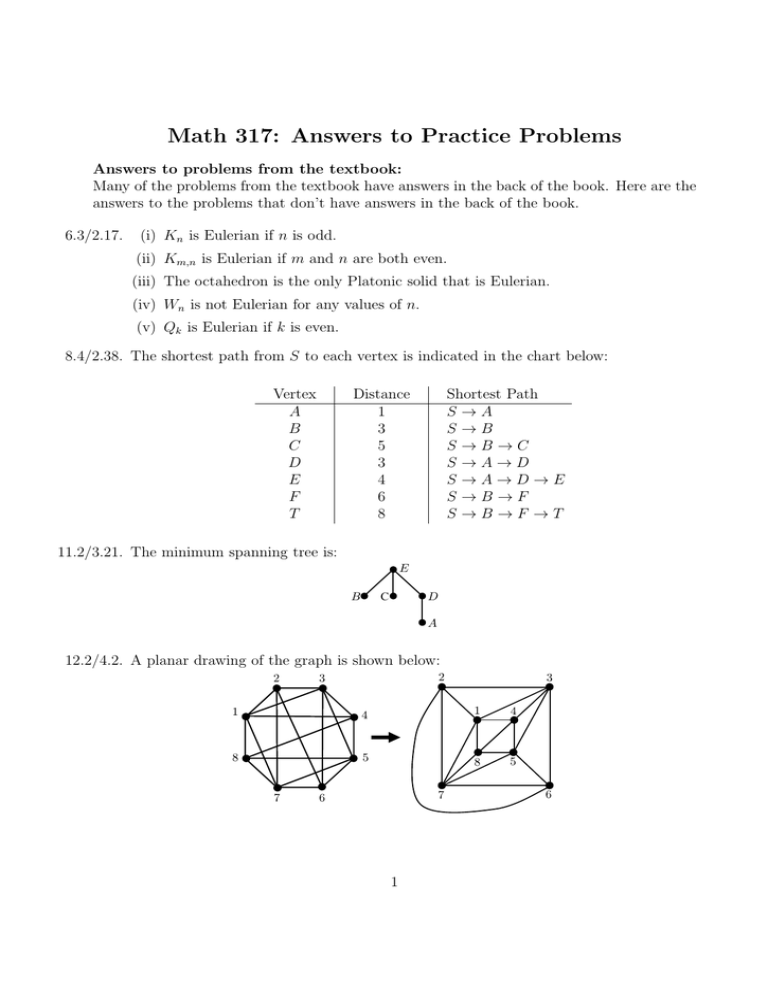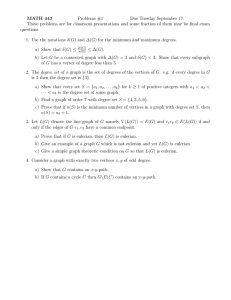Math 317: Answers to Practice Problems
advertisement

Math 317: Answers to Practice Problems
Answers to problems from the textbook:
Many of the problems from the textbook have answers in the back of the book. Here are the
answers to the problems that don’t have answers in the back of the book.
6.3/2.17.
(i) Kn is Eulerian if n is odd.
(ii) Km,n is Eulerian if m and n are both even.
(iii) The octahedron is the only Platonic solid that is Eulerian.
(iv) Wn is not Eulerian for any values of n.
(v) Qk is Eulerian if k is even.
8.4/2.38. The shortest path from S to each vertex is indicated in the chart below:
Vertex
A
B
C
D
E
F
T
Distance
1
3
5
3
4
6
8
11.2/3.21. The minimum spanning tree is:
Shortest Path
S→A
S→B
S→B→C
S→A→D
S→A→D→E
S→B→F
S→B→F →T
E
B
D
C
A
12.2/4.2. A planar drawing of the graph is shown below:
2
2
3
3
1
4
1
4
8
5
8
5
7
7
6
1
6
Answers to problems not from the textbook:
1. The two graphs are isomorphic, as shown in the following labeling:
1
7
8
11
14
6
14
12
3
9
10
5
13
8
2
9
1
6
3
4
13
4
10
5
2
12
7
11
2. (a) There is one simple graph with 5 vertices and 9 edges. It is created by removing
one edge from K5 :
(b) There are two simple graphs with 5 vertices and 8 edges. Both are created by
removing two edges from K5 : one is created by removing two edges that share a
vertex, the other is created by removing two disjoint edges.
3. The first graph is Eulerian, because every vertex has degree 4 (which is even). The
second graph is not Eulerian, because it has a vertex of degree three and a vertex of
degree five; these vertices are circled in the picture below:
4. The first graph is not Hamiltonian. The second graph is Hamiltonian, and a Hamiltonian cycle is marked in bold below:
2
5. (a) Kn is Hamiltonian for all n > 2.
(b) Complete bipartite graphs are Hamiltonian if and only if the two sets A and B
both have the same number of vertices, and both have more than one vertex.
Thus, Kn,n with n > 1 is bipartite.
6. The minimum weight spanning tree for G is:
b
a
c
e
d
7. κ(G) = 1 and λ(G) = 2
8. There are many such graphs. One example is:
9. 30 edges, 12 faces
10. The first graph is not planar. As shown below, if we contract edge {3, 5} and edge
{2, 4} (removing any double edges), we get K5 .
1
1
2
7
1
2
7
2,4
7
3
6
3,5
6
6
4
3,5
4
5
The second graph is planar. A planar drawing of the second graph is shown below:
3
The third graph is not planar. As shown below, if we remove the dotted edges, the
resulting graph is a subdivided K3,3 . The circled vertices correspond to one set of
vertices in K3,3 , and the squared vertices correspond to the other set. There is an edge
or a subdivided edge between every circled vertex and every squared vertex.
1
5
6
2
4
3
4
1
4
2
5
3
6







